| Article ID | Journal | Published Year | Pages | File Type |
|---|---|---|---|---|
| 8983795 | Meat Science | 2005 | 6 Pages |
Abstract
When striploins were mechanically tenderized at a beef packing plant, the log total numbers of aerobes, coliforms, staphylococci/listerias and Escherichia coli recovered from surfaces before or after tenderizing were about 2.8, 2.0, 0.6 and 0.3 log cfu 25 cmâ2, respectively. The numbers of those organisms recovered from the deep tissues of the tenderized meat were about 2.0, 1.5 and 1.2 log cfu 25 gâ1 and none, respectively. The aerobes recovered from the deep tissues were unexpectedly numerous in view of the small numbers of bacteria on meat surfaces. That suggests deep tissue contamination was affected by factors other than the numbers on meat surfaces. After cooking tenderized beef to medium rare or well done conditions, with maximum temperatures at steak centres of ⩽65.4 or ⩽73.4 °C, respectively, aerobes were recovered from only 2 of 25 samples cooked to each condition, at numbers of one or two per sample. This indicates that such cooking can ensure the microbiological safety of mechanically tenderized beef prepared under controlled conditions.
Keywords
Related Topics
Life Sciences
Agricultural and Biological Sciences
Food Science
Authors
C.O. Gill, J.C. McGinnis, K. Rahn, D. Young, N. Lee, S. Barbut,
